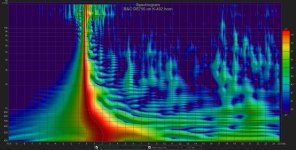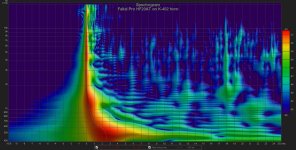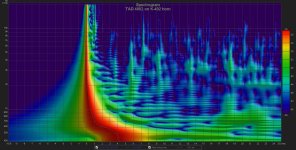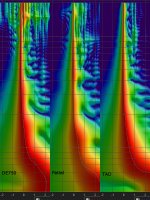P.S. Sorry I can't make the plots bigger as these images
*.png isn't optimal for pics like this. Try simply *.jpg))
Why the arguments ????
Horns have always been built around the driver of yesteryear inducing honk to extrapolate lower frequencies
The quest of the maximum efficiency with the smallest footprint as possible.
One of these has just had an excellent resolution: Parts Express gave me a refund for the entire order (8 items) because one of the compression drivers had arrived damaged.I've shipped gear from the USA four times, and two of these deliveries have arrived with parts broken. For me to send something back and then wait for a replacement takes a lot longer (and more $) than it will for a US resident.
My confidence in shipping gear from the US has increased
I don't see spectrograms often, so I went back to this post for the .pfd file, to re-read some tips from Jean-Michel Le Cléac’h tips on how to interpret them.
High Efficiency Speaker Asylum
So most of the valid info is in the first ms or two, right? The JMMLC pdf indicates that HF resonances are in the first 1ms.
The Le Cléac’h plots were "done inside a very large room" and "First visible reflection of the room comes after 7.5ms", so presumably anything over this is guff.
When I look at your 3 plots, focusing on the first few ms, the DE750 looks very bad at 15kHz, which I can understand - it matches up with the big spike on the driver's spec sheet.
So: if this 15kHz spike was notched out with DSP, would it largely 'fix' the spectrogram? Is there anything else on the spectrogram that would explain why the Faital would sound better than the DE750?
My (limited) experience seems to be that even with the bad bits notched out, there is still something wrong with (big) titanium diaphragms - It'd be nice to know that there is a measurable way to show this.
The TAD seems to have the cleanest plot >10kHz. The TAD also lacks 'pre ringing' (which is something I don't understand - how does a diaphragm 'know' that a signal is coming? A Google search on the term only turns up info on digital filters).
The Le Cléac’h pdf is not an apples-to-apples comparison like this, but those plots also make the beryllium diaphragms look very good.
High Efficiency Speaker Asylum
By the way, that 1ms bounce energy that's clearly shown on the TAD plot, above, is apparently mouth bounce and "baffle step bounce" where the final acoustic wave radiates off the front flange of the horn. The horn itself is about 15" depth--just under 1 ms transit time.
So most of the valid info is in the first ms or two, right? The JMMLC pdf indicates that HF resonances are in the first 1ms.
The Le Cléac’h plots were "done inside a very large room" and "First visible reflection of the room comes after 7.5ms", so presumably anything over this is guff.
When I look at your 3 plots, focusing on the first few ms, the DE750 looks very bad at 15kHz, which I can understand - it matches up with the big spike on the driver's spec sheet.
So: if this 15kHz spike was notched out with DSP, would it largely 'fix' the spectrogram? Is there anything else on the spectrogram that would explain why the Faital would sound better than the DE750?
My (limited) experience seems to be that even with the bad bits notched out, there is still something wrong with (big) titanium diaphragms - It'd be nice to know that there is a measurable way to show this.
The TAD seems to have the cleanest plot >10kHz. The TAD also lacks 'pre ringing' (which is something I don't understand - how does a diaphragm 'know' that a signal is coming? A Google search on the term only turns up info on digital filters).
The Le Cléac’h pdf is not an apples-to-apples comparison like this, but those plots also make the beryllium diaphragms look very good.
Attachments
I posted that information in order to point out that generalizations on "2 inch titanium diaphragms" should be offset based on the relatively good experience with the Faital Pro driver(s). If the Faitals can do it well, then it can be done well using titanium diaphragms on 2" throat drivers.
In terms of what you can do with the B&C, I'd recommend using a tweeter to avoid that portion of the driver's frequency band (about 12 kHz on up), so crossing at 8-9 kHz to a tweeter works well. I did this with a P.Audio BM-D750 series I driver to a Beyma CP25 tweeter at 8 kHz and the performance measured very well.
The problem of course comes if you're trying to use a 2" B&C driver for MEH duty. I'd personally recommend a Faital Pro or dual-diaphragm BMS driver instead for MEH duty. The B&Cs that I've seen just don't damp their diaphragm breakup modes like the Faital Pros. I'm not sure what the difference is in design.
I've tried a narrow notch on the break-up mode at 13.8 kHz using the P.Audio driver, but I missed the spectrum immediately in listening, and instead went to the separate Beyma tweeter with good success.
But I was not doing a MEH at that point--rather a tri-amped "JuBelle" (Belle bass bin, K-510 midrange, Beyma CP25 tweeter) and had a very solid center channel between my two Jubs--and the timbre matched well. The only thing that it lacked was apparent source width (ASW). I created the K-402-MEH prototype to solve the ASW issue.
I'm not sure about the pre-ringing, but it may be an artifact of the up-sweep conversion process (collapsing the up-sweep into an impulse plot algorithmically) which produces the pre-ringing. I do know that there is a great deal of acoustic ringing that is occurring near the diaphragm break-up modes, and this splatters about in the up-sweep and the resulting constructed impulse response plots. If the diaphragm was well damped, or if it were as light and stiff as beryllium (about a factor of 7 improvement in stiffness-lightweight performance over titanium), you don't see all the ringing or pre-ringing.
In terms of what you can do with the B&C, I'd recommend using a tweeter to avoid that portion of the driver's frequency band (about 12 kHz on up), so crossing at 8-9 kHz to a tweeter works well. I did this with a P.Audio BM-D750 series I driver to a Beyma CP25 tweeter at 8 kHz and the performance measured very well.
The problem of course comes if you're trying to use a 2" B&C driver for MEH duty. I'd personally recommend a Faital Pro or dual-diaphragm BMS driver instead for MEH duty. The B&Cs that I've seen just don't damp their diaphragm breakup modes like the Faital Pros. I'm not sure what the difference is in design.
I've tried a narrow notch on the break-up mode at 13.8 kHz using the P.Audio driver, but I missed the spectrum immediately in listening, and instead went to the separate Beyma tweeter with good success.
But I was not doing a MEH at that point--rather a tri-amped "JuBelle" (Belle bass bin, K-510 midrange, Beyma CP25 tweeter) and had a very solid center channel between my two Jubs--and the timbre matched well. The only thing that it lacked was apparent source width (ASW). I created the K-402-MEH prototype to solve the ASW issue.
I'm not sure about the pre-ringing, but it may be an artifact of the up-sweep conversion process (collapsing the up-sweep into an impulse plot algorithmically) which produces the pre-ringing. I do know that there is a great deal of acoustic ringing that is occurring near the diaphragm break-up modes, and this splatters about in the up-sweep and the resulting constructed impulse response plots. If the diaphragm was well damped, or if it were as light and stiff as beryllium (about a factor of 7 improvement in stiffness-lightweight performance over titanium), you don't see all the ringing or pre-ringing.
One more thing that I should add...
One of the most useful statements that I got off of Dave Griesinger's web site is that "the human hearing system has about a 1ms response time". What this means to me is that if you can confine the ringing to 0.7-1ms duration, it begins to sound like a acoustic source that doesn't ring at all.
I've kept that observation in mind when looking at compression driver responses. There is no such thing as a electro-mechanical driver that doesn't ring at high frequencies--unless heavily damped. The real question is: at what frequency does it ring? If that frequency is above 20 kHz, you're basically home free. This is what the Be diaphragm drivers are doing--pushing the ringing up at least one octave into a regime that the human hearing system can't detect.
Chris
One of the most useful statements that I got off of Dave Griesinger's web site is that "the human hearing system has about a 1ms response time". What this means to me is that if you can confine the ringing to 0.7-1ms duration, it begins to sound like a acoustic source that doesn't ring at all.
I've kept that observation in mind when looking at compression driver responses. There is no such thing as a electro-mechanical driver that doesn't ring at high frequencies--unless heavily damped. The real question is: at what frequency does it ring? If that frequency is above 20 kHz, you're basically home free. This is what the Be diaphragm drivers are doing--pushing the ringing up at least one octave into a regime that the human hearing system can't detect.
Chris
I've not yet caught the MEH bug, but I like the look / theory / measurements of your MEH system, and the simplicity of the 402.I'd personally recommend a Faital Pro or dual-diaphragm BMS driver instead for MEH duty. The B&Cs that I've seen just don't damp their diaphragm breakup modes like the Faital Pros. I'm not sure what the difference is in design.
I'll keep those drivers in mind, but will probably test the waters with a lower efficiency version before buying more CDs.
That's different to my experience, but possibly because I was aiming for flat, whereas you sound like you notched below flat (and got a different problem).I've tried a narrow notch on the break-up mode at 13.8 kHz using the P.Audio driver, but I missed the spectrum immediately in listening, and instead went to the separate Beyma tweeter with good success.
It comes from equalising to a single response measurement rather than measuring power. The behaviour at breakup is too complex for this.notched below flat (and got a different problem).
It comes from equalising to a single response measurement rather than measuring power.
Cask05 is pretty obsessive about polar response, I doubt he forgot about it in this instance
For most people, the simple solution is just to use a super tweeter (and avoid using the the 2" CD in the break up range), but:
The only thing that it lacked was apparent source width (ASW).
I don't perceive it this way, or maybe I don't think in the same terms. For me, adding a tweeter just sounds a bit less natural on (some) music. I've had coaxials for years as my default system, so it might be that I'm very used to hearing a ~point source.
True but I haven't noticed anyone on this site, apart from myself and Earl Geddes, that do actual power calculations.Cask05 is pretty obsessive about polar response,
Well, you could start to open up the discussion on power, but it remains that the Ti diaphragm is behaving not like a piston but rather like a membrane, while the Be diaphragm still is behaving like a piston--at these frequencies. And as you up-sweep the drive signal, it's pushing that Ti membrane into very complex internal energy modes that change very rapidly with small changes in drive frequency.
The phase plug adds its own dynamics to the summed output on the horn throat side of the assembly, so the result isn't very easy to lump into power- or SPL-only states, but rather like a 3-D impedance state.
The effects of power output vs. SPL on-axis can begin to be seen in the spectrogram plot above 12 kHz, reproduced again here:
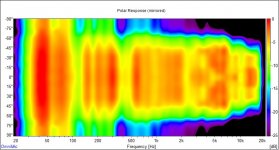
So the picture gets messy and the returns on the investment of time in understanding and dealing with the dynamics and the 3D effects begins to lessen in its eventual payoff. The good thing is that the human hearing system really can't hear the harmonics or discern much about the summed SPL direct arrivals vs. power summation of the closely off-axis energy, It all begins to sound like direct arrivals due to the higher absorption characteristics of the horn walls and perhaps phase plug materials (for polymer phase plugs) at those frequencies, as well as the inabilities of the processing portion of the human hearing system (being a basic 1ms system that I mentioned earlier) to sort out the differences. You're basically at the detection-only portion of the audio spectrum, and the sensitivity of the detection portion of the hearing system is rapidly declining, perhaps even more rapidly due to presbycusis.
The phase plug adds its own dynamics to the summed output on the horn throat side of the assembly, so the result isn't very easy to lump into power- or SPL-only states, but rather like a 3-D impedance state.
The effects of power output vs. SPL on-axis can begin to be seen in the spectrogram plot above 12 kHz, reproduced again here:

So the picture gets messy and the returns on the investment of time in understanding and dealing with the dynamics and the 3D effects begins to lessen in its eventual payoff. The good thing is that the human hearing system really can't hear the harmonics or discern much about the summed SPL direct arrivals vs. power summation of the closely off-axis energy, It all begins to sound like direct arrivals due to the higher absorption characteristics of the horn walls and perhaps phase plug materials (for polymer phase plugs) at those frequencies, as well as the inabilities of the processing portion of the human hearing system (being a basic 1ms system that I mentioned earlier) to sort out the differences. You're basically at the detection-only portion of the audio spectrum, and the sensitivity of the detection portion of the hearing system is rapidly declining, perhaps even more rapidly due to presbycusis.
I'd recommend using a tweeter to avoid that portion of the driver's frequency band (about 12 kHz on up)
On witch type of music do you find the lack of treble ?
Well, since Kenny Clarke began the tradition in the 1940s, it's been largely bebop jazz and its subgenres that largely shows the effects of ride cymbal use over bass drum. However, stereo recordings with response to 20 kHz didn't start to become the norm until about 1960-61. Then bebop and cool jazz recordings become the signature genre for this type of music that exhibits lots of ride cymbal use.
Personally, I'm a Modern Jazz Quartet type of guy, but most of their 1950s recordings roll off sharply at 10-12 kHz. It wasn't until the early 1960s that Connie Kay's ride cymbal sounds anything like the real thing. This is one of the reasons why I don't listen to their recordings daily--the muffled, rolled off and splattered cymbal sound begins to grate. Only some of their later '50s recordings respond to demastering to restore the rolled-off highs above 10 kHz, but most are full of just tape (background) noise.
Other recordings with a lot of high frequency percussion effects to include finger cymbals and little finger chimes, etc. include light jazz and nigh club pop. It usually takes fairly close miking to capture these type of recordings.
Chris
Personally, I'm a Modern Jazz Quartet type of guy, but most of their 1950s recordings roll off sharply at 10-12 kHz. It wasn't until the early 1960s that Connie Kay's ride cymbal sounds anything like the real thing. This is one of the reasons why I don't listen to their recordings daily--the muffled, rolled off and splattered cymbal sound begins to grate. Only some of their later '50s recordings respond to demastering to restore the rolled-off highs above 10 kHz, but most are full of just tape (background) noise.
Other recordings with a lot of high frequency percussion effects to include finger cymbals and little finger chimes, etc. include light jazz and nigh club pop. It usually takes fairly close miking to capture these type of recordings.
Chris
The TAD 4002s are superb in every way. Is that what you wanted to know?
If you use a 2" compression driver that chatters badly above 12 kHz, then it will sound fairly bad. I guess that's a fairly universal experience.
But you don't have to listen to 2" compression drivers that present a lot of chatter, as I've stated above. And the price doesn't really rise to achieve that.
And I've found empirically that the number and strength of the PEQ and shelving biquads required to correct the response using controlled directivity horns back to flat on-axis is much less using these lower chatter compression drivers than the type that chatter badly. YMMV.
__________________________________________________
My experience with 1" compression drivers is that many people that typically use those types of drivers don't select their drivers with the performance of the TAD 4002s or even the Faital Pros listed above. So the comparison would be an unfair one.
I think you're trying to compare apples to apples 2" to 1", and I'm not sure that its ever going to be a fair comparison because the 2" compression drivers of good non-chattering quality will have lower distortion and fewer and less audible crossover-derived disturbances stemming from poorly matched electrical crossover filters and mismatched coverage angles (horizontally and vertically) at the crossover bands.
So the comparison needs to be controlled for those factors, too. If you implement a good 1" driver design that equals the 2" driver design, my experience is this: it will almost always take you more effort to do it well--and this usually means more money, too.
I fear that the apparent source width (ASW) thing will rear its head again because most people are using small HF horns that do not control their polars very well on the lower end of their frequency bands (and you have to hear this in person to understand what I'm saying). Also, the midrange drivers used are too often direct radiator woofers or midrange cones, which have undesirable polar coverage slopes vs. frequency and that also experience much higher levels of modulation distortion (i.e., muddy sound). No one that I know chooses a narrow ASW loudspeaker over the wider one of equal quality--up to about 90 degrees coverage horizontally, unless they have severe room acoustics issues (which is in agreement with Toole's comments on that subject).
So in balance, it's usually never a "2 inch vs. 1 inch compression driver" comparison only.
__________________________________________________
If I were to use a 1" compression driver, it would probably be on an MEH design using a DSP crossover...and I would do this in order to reduce the apparent parts costs of the drivers for perceived cost savings...but not really real cost savings.
Chris
If you use a 2" compression driver that chatters badly above 12 kHz, then it will sound fairly bad. I guess that's a fairly universal experience.
But you don't have to listen to 2" compression drivers that present a lot of chatter, as I've stated above. And the price doesn't really rise to achieve that.
And I've found empirically that the number and strength of the PEQ and shelving biquads required to correct the response using controlled directivity horns back to flat on-axis is much less using these lower chatter compression drivers than the type that chatter badly. YMMV.
__________________________________________________
My experience with 1" compression drivers is that many people that typically use those types of drivers don't select their drivers with the performance of the TAD 4002s or even the Faital Pros listed above. So the comparison would be an unfair one.
I think you're trying to compare apples to apples 2" to 1", and I'm not sure that its ever going to be a fair comparison because the 2" compression drivers of good non-chattering quality will have lower distortion and fewer and less audible crossover-derived disturbances stemming from poorly matched electrical crossover filters and mismatched coverage angles (horizontally and vertically) at the crossover bands.
So the comparison needs to be controlled for those factors, too. If you implement a good 1" driver design that equals the 2" driver design, my experience is this: it will almost always take you more effort to do it well--and this usually means more money, too.
I fear that the apparent source width (ASW) thing will rear its head again because most people are using small HF horns that do not control their polars very well on the lower end of their frequency bands (and you have to hear this in person to understand what I'm saying). Also, the midrange drivers used are too often direct radiator woofers or midrange cones, which have undesirable polar coverage slopes vs. frequency and that also experience much higher levels of modulation distortion (i.e., muddy sound). No one that I know chooses a narrow ASW loudspeaker over the wider one of equal quality--up to about 90 degrees coverage horizontally, unless they have severe room acoustics issues (which is in agreement with Toole's comments on that subject).
So in balance, it's usually never a "2 inch vs. 1 inch compression driver" comparison only.
__________________________________________________
If I were to use a 1" compression driver, it would probably be on an MEH design using a DSP crossover...and I would do this in order to reduce the apparent parts costs of the drivers for perceived cost savings...but not really real cost savings.
Chris
I've heard them with JMLC concrete horns and plywood biradial horns... they are painfully expensive and full of toxic materials.The TAD 4002s are superb in every way. Is that what you wanted to know?
Yes, but what is the factual problem ? is it measurable ?If you use a 2" compression driver that chatters badly above 12 kHz, then it will sound fairly bad. I guess that's a fairly universal experience.
I feel that titanium domes can sound relatively clean in that zone, yes, even in the disturbance of the breakups area.
My goal was to improve the intelligibility of the voice frequency range at very low volumes by increasing the efficiency in that zone, the 1" is vastly beaten under 2K.But you don't have to listen to 2" compression drivers that present a lot of chatter, as I've stated above. And the price doesn't really rise to achieve that.
When the directivity is compromised by a very, very small room and a very small footprint, which parameter should retain your attention ?And I've found empirically that the number and strength of the PEQ and shelving biquads required to correct the response using controlled directivity horns back to flat on-axis is much less using these lower chatter compression drivers than the type that chatter badly. YMMV.
Let's just leave it at where we are, and "agree to disagree" if that would be agreeable..
If you and I were in the same room, perhaps we could find more to agree on and talk about that's mutually beneficial. That's been my experience in general. Listening to loudspeakers in our listening rooms together also brings opinions much closer together in my experience.
Best regards,
Chris A
If you and I were in the same room, perhaps we could find more to agree on and talk about that's mutually beneficial. That's been my experience in general. Listening to loudspeakers in our listening rooms together also brings opinions much closer together in my experience.
Best regards,
Chris A
Here is a LTH142 fitted with an SB65WB25AC-4 (fullrange 2.5in alum cone driver):
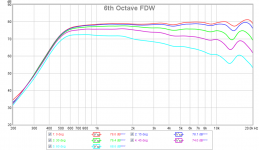
More here:
A Bookshelf Multi-Way Point-Source Horn

More here:
A Bookshelf Multi-Way Point-Source Horn
- Home
- Loudspeakers
- Multi-Way
- Smallest Footprint Horn and Driver that can reach 500 Hz
